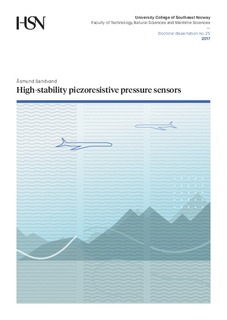| dc.contributor.author | Sandvand, Åsmund | |
| dc.date.accessioned | 2017-09-27T11:32:13Z | |
| dc.date.available | 2017-09-27T11:32:13Z | |
| dc.date.issued | 2017 | |
| dc.identifier.isbn | 978-82-7860-305-5 | |
| dc.identifier.issn | 2464-2843 | |
| dc.identifier.uri | http://hdl.handle.net/11250/2457060 | |
| dc.description.abstract | Piezoresistive pressure sensors have been in use for decades and are among the most successful micromachined sensors. From their introduction in the 1960s, they have experienced a dramatic improvement on performance and stability, as new microfabrication techniques have been developed. For high-accuracy avionic applications, there is a strong focus on the long-term stability of the sensor output-signal. Higher stability makes increased service-intervals possible and open the doors to new applications areas. This thesis focuses on possible root causes influencing the stability for piezoresistive pressure sensors. Although the main focus has been on the SP82-design from MEMSCAP, the results are relevant also for other sensor designs using similar packaging technologies.
It has been found that even small amounts of excess glass frit material in the die lamination process may cause a major influence on the sensor zero point and temperature sensitivity. High residual stress in the excess glass frit volume will also result in increased risk for mechanical stress release in the form of microcrack formation. By optimizing the glass frit distribution, the influence from the die lamination on the sensor output-signal has been reduced and the stability has been improved.
Another major finding has been that the use of a thermoset polymer as a die-attach material might result in an unwanted signal drift when the sensors are stored for weeks under ambient environmental conditions. This was found to be caused by diffusion of water into the polymer, leading to spatially localized swelling with resulting mechanical stress changes, combined with physical aging. A new support die design has been designed and tested, reducing this effect to neglectable levels.
The sensitivity of a sealed sensor structure to changes in the sensor cap pressure has been modelled and experimentally verified. Examples of resulting influence from various storage conditions on signal drift as well as characteristic over temperature are demonstrated, and resulting hermeticity requirements are discussed.
A new metallization pattern for in situ observation of metal properties in a piezoresistive pressure sensor has been developed and initial testing has been performed. By limiting the design change to the metal mask only, this provides a cost effective approach for characterizing of metal properties where the test structure can be combined with functional devices on the same wafer. | nb_NO |
| dc.language.iso | eng | nb_NO |
| dc.publisher | University College of Southeast Norway | nb_NO |
| dc.relation.ispartofseries | Doctoral dissertations at the University College of Southeast Norway;25 | |
| dc.relation.ispartofseries | | |
| dc.relation.haspart | 1. Å. Sandvand, E. Halvorsen and K.E. Aasmundtveit, “Finite element modelling of influence of bonding material distribution in precision piezoresistive MEMS pressure-sensors”, Electronics System-Integration Technology Conference (ESTC), Helsinki, Finland, 16-18 September 2014, DOI: 10.1109/ESTC.2014.6962829 | nb_NO |
| dc.relation.haspart | 2. Å. Sandvand, E. Halvorsen, K.E. Aasmundtveit and H. Jakobsen, “Influence of sensor-package hermeticity-level on long-term drift for a piezoresistive MEMS pressure-sensor”, Microelectronics Packaging Conference (EMPC), Friedrichshafen, Germany, 14-16 September 2015 | nb_NO |
| dc.relation.haspart | 3. Å. Sandvand, E. Halvorsen, K.E. Aasmundtveit and H. Jakobsen, “Influence of Glass-Frit Material Distribution on the Performance of Precision Piezoresistive MEMS Pressure Sensors”, IEEE Transactions on Components, Packaging and Manufacturing Technology (TCPMT), Volume 5, Issue 11 (2015), Pages 1559-1566, DOI: 10.1109/TCPMT.2015.2486018 | nb_NO |
| dc.relation.haspart | 4. Å. Sandvand, E. Halvorsen, K.E. Aasmundtveit and H. Jakobsen, “Identification and elimination of hygro-thermo-mechanical stress-effects in a high-precision MEMS pressure sensor”, IEEE Journal of Microelectromechanical Systems (JMEMS), Volume 26, Issue 2 (2017), Pages 415-423, DOI:10.1109/JMEMS.2017.2651162 | nb_NO |
| dc.relation.haspart | Å. Sandvand, E. Halvorsen and H. Jakobsen, “In situ observation of metal properties in a piezoresistive pressure sensor”, accepted for publication in IEEE Journal of Microelectromechanical Systems (JMEMS) DOI:10.1109/JMEMS.2017.2747090 | nb_NO |
| dc.subject | Mikrosensorer | nb_NO |
| dc.title | High-stability piezoresistive pressure sensors | nb_NO |
| dc.type | Doctoral thesis | nb_NO |
| dc.subject.nsi | VDP::Teknologi: 500::Nanoteknologi: 630 | nb_NO |
| dc.source.pagenumber | 78 | nb_NO |
| cristin.fulltext | | |
| cristin.fulltext | | |
